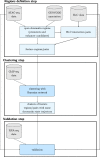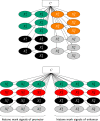Inferring time series chromatin states for promoter-enhancer pairs based on Hi-C data
- PMID: 33509077
- PMCID: PMC7841892
- DOI: 10.1186/s12864-021-07373-z
Inferring time series chromatin states for promoter-enhancer pairs based on Hi-C data
Abstract
Background: Co-localized combinations of histone modifications ("chromatin states") have been shown to correlate with promoter and enhancer activity. Changes in chromatin states over multiple time points ("chromatin state trajectories") have previously been analyzed at promoter and enhancers separately. With the advent of time series Hi-C data it is now possible to connect promoters and enhancers and to analyze chromatin state trajectories at promoter-enhancer pairs.
Results: We present TimelessFlex, a framework for investigating chromatin state trajectories at promoters and enhancers and at promoter-enhancer pairs based on Hi-C information. TimelessFlex extends our previous approach Timeless, a Bayesian network for clustering multiple histone modification data sets at promoter and enhancer feature regions. We utilize time series ATAC-seq data measuring open chromatin to define promoters and enhancer candidates. We developed an expectation-maximization algorithm to assign promoters and enhancers to each other based on Hi-C interactions and jointly cluster their feature regions into paired chromatin state trajectories. We find jointly clustered promoter-enhancer pairs showing the same activation patterns on both sides but with a stronger trend at the enhancer side. While the promoter side remains accessible across the time series, the enhancer side becomes dynamically more open towards the gene activation time point. Promoter cluster patterns show strong correlations with gene expression signals, whereas Hi-C signals get only slightly stronger towards activation. The code of the framework is available at https://github.com/henriettemiko/TimelessFlex .
Conclusions: TimelessFlex clusters time series histone modifications at promoter-enhancer pairs based on Hi-C and it can identify distinct chromatin states at promoter and enhancer feature regions and their changes over time.
Keywords: Chromatin immunoprecipitation; Differentiation; Enhancer; Gene regulation; Hi-C; Histone modifications.
Conflict of interest statement
The authors declare that they have no competing interests.
Figures













Similar articles
-
HiCoP, a simple and robust method for detecting interactions of regulatory regions.Epigenetics Chromatin. 2020 Jul 1;13(1):27. doi: 10.1186/s13072-020-00348-6. Epigenetics Chromatin. 2020. PMID: 32611439 Free PMC article.
-
Characterizing chromatin interactions of regulatory elements and nucleosome positions, using Hi-C, Micro-C, and promoter capture Micro-C.Epigenetics Chromatin. 2022 Dec 21;15(1):41. doi: 10.1186/s13072-022-00473-4. Epigenetics Chromatin. 2022. PMID: 36544209 Free PMC article.
-
Different enhancer classes in Drosophila bind distinct architectural proteins and mediate unique chromatin interactions and 3D architecture.Nucleic Acids Res. 2017 Feb 28;45(4):1714-1730. doi: 10.1093/nar/gkw1114. Nucleic Acids Res. 2017. PMID: 27899590 Free PMC article.
-
Functional genomic assays to annotate enhancer-promoter interactions genome wide.Hum Mol Genet. 2022 Oct 20;31(R1):R97-R104. doi: 10.1093/hmg/ddac204. Hum Mol Genet. 2022. PMID: 36018818 Free PMC article. Review.
-
Enhancer selectivity in space and time: from enhancer-promoter interactions to promoter activation.Nat Rev Mol Cell Biol. 2024 Jul;25(7):574-591. doi: 10.1038/s41580-024-00710-6. Epub 2024 Feb 27. Nat Rev Mol Cell Biol. 2024. PMID: 38413840 Free PMC article. Review.
Cited by
-
3DFAACTS-SNP: using regulatory T cell-specific epigenomics data to uncover candidate mechanisms of type 1 diabetes (T1D) risk.Epigenetics Chromatin. 2022 Jun 30;15(1):24. doi: 10.1186/s13072-022-00456-5. Epigenetics Chromatin. 2022. PMID: 35773720 Free PMC article.
-
Functional Aspects of Sperm Chromatin Organization.Results Probl Cell Differ. 2022;70:295-311. doi: 10.1007/978-3-031-06573-6_10. Results Probl Cell Differ. 2022. PMID: 36348112 Free PMC article. Review.
-
Hi-C, a chromatin 3D structure technique advancing the functional genomics of immune cells.Front Genet. 2024 Mar 22;15:1377238. doi: 10.3389/fgene.2024.1377238. eCollection 2024. Front Genet. 2024. PMID: 38586584 Free PMC article. Review.
References
-
- Libbrecht MW, Ay F, Hoffman MM, Gilbert DM, Bilmes JA, Noble WS. Joint annotation of chromatin state and chromatin conformation reveals relationships among domain types and identifies domains of cell type-specific expression. Genome Res. 2015;25(4):544–557. doi: 10.1101/gr.184341.114. - DOI - PMC - PubMed
MeSH terms
Substances
Grants and funding
LinkOut - more resources
Full Text Sources
Other Literature Sources
Molecular Biology Databases

